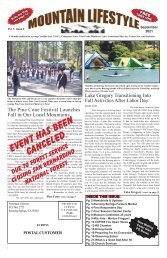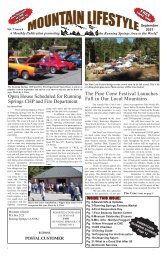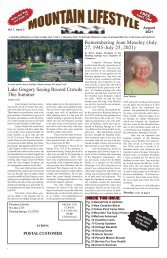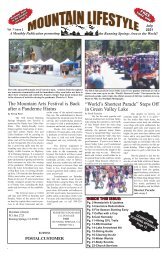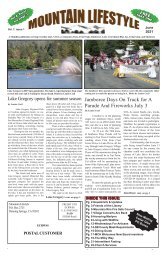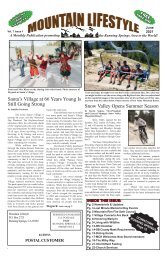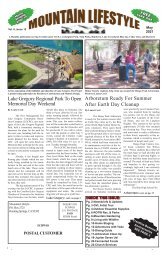You also want an ePaper? Increase the reach of your titles
YUMPU automatically turns print PDFs into web optimized ePapers that Google loves.
MOUNTAIN GARDENING
By Michele martinez
Hummingbird on Bush Monkeyflower by Master Gardener, photo by Hank
Morales
Starting Wildflowers from Seed
by Michele Martinez
California is home to an incredible
variety of native wildflowers.
Flowering plants not only brighten
hillsides each spring, they aid in
erosion control, and they help protect
properties from wildfire. Though we
may not often think of it, a carpeting
of green plants dotted with wildflowers
can act as a “fire break.” Healthy
gardens can hinder the spread of
flames because they provide a moist
environment, rather than tinder. We
know about the life-sustaining nour-
ishment that wildflowers provide for
pollinators, but why discuss flowers
now, as cold days are upon us? The
quick answer is that fall is seed-sowing
time for wildflowers.
In recent years, a number of
Southern California organizations
have entered into the business of habitat
conservation. Projects like Claremont’s
California Botanic Garden
(formerly Rancho Santa Ana Garden),
and Sunland’s Theodore Payne
Foundation enlist teams of scientists
and laypeople to collect native plant
seeds and educate the public about
preserving native habitats. According
to California Botanic Garden, “fall
into winter is the perfect time to plant
many native plants.”
Most nurseries stock wildflower
seed packets and the above
organizations sell specialty wildflower
seeds through their online stores.
Theodore Payne has an extensive
online catalog (www.store.theodorepayne.org/seeds/),
and California
Botanic Garden opens its store November
5 for online purchases and
curb-side pickup (www.calbg.org/
grow-native-nursery/gnn). Remember
when selecting flower seeds to
have a look at the areas around the
home that you may want to plant.
Most mountain garden spaces fall
into two categories, the drier “sunny
garden,” and cooler “shade garden”
plots. Seed packets always come with
instructions, but generally, seed is
scattered, then covered loosely with
soil, and watered lightly. Nature will
do the rest.
The following is an introductory
list of wildflowers that thrive in
our mountains. You’ll see many of
these when you are out walking or
driving in spring. If you’re looking to
learn more about wildflower habitats,
Heaps Peak Arboretum, in Skyforest,
hosts demonstration gardens. The
arboretum also publishes wildflower
books and an illustrated poster by
local artist and plant specialist, Gina
Richmond. These products are available
year round at the Heaps Peak
Arboretum info booth. The following
wildflowers are selections from the
Arboretum’s publication, Wildflowers
of the San Bernardino Mountains.
Sunny Garden Habitats
Many hillside gardens fit into
this category. Most of “sunny garden”
plants thrive in sandy gravel and
even clay-based soils. Once planted,
native wildflowers must be watered
regularly during the first two years.
Then, when they are established, the
hearty flowering plants will continue
to bloom and re-seed themselves every
fall.
Red Penstemons. Our native
red beard-tongue (Penstemon labrusus)
is the brilliant crimson bloom
seen along highways in late summer.
Penstemons will take hold on the
steepest hillside and flower beds will
spread as plants re-seed themselves
each year.
Grand Collomia. With its
clusters of salmon-pink flowers, Collomia
(Collomia grandiflora) attracts
both bees and butterflies. They grow
very well on dry, sunny hillsides.
Monkeyflower. Another
hillside resident, Crimson Monkeyflower
(Mimulus cardinalis) and the
yellow Bush Monkeyflower (Mimulus
aurantiacus) put on a brilliant
show along the slopes off Highway
18. Monkeyflowers set their seeds in
among granite boulders, and return
year after year. They attract many
species of native butterflies.
Tongue clarkia. Clarkias
(Clarkia rhomboidea) bloom in late
summer with a four-petal splash of
magenta. The resilient little flowers
dot landscapes, even on the driest
hillsides. They also re-seed themselves
each year.
Brewer’s Lupine. Of the
many Lupines seen in the mountains,
Brewer’s Lupine (Lupinus breweri)
is one of the most common. It grows
in granite soil, spreading a carpet of
pale green foliage and lavender flowers.
This legume-type plant is beneficial,
in that it restores nitrogen to depleted
soils. It also attracts California
Blue butterflies.
Shaded Garden Habitats.
Unlike “sunny garden” plants,
shade-loving wildflowers must be
watered regularly. If you have a nice
shady spot, the following wildflowers
are easy to grow.
Wild Strawberries. The Wild
Strawberry (Fregaria vesca) is an excellent
ground cover plant. It thrives
in damp, shaded areas. Spring’s tiny
white flowers yield mini red strawberries,
in summer. You’ll have to
harvest the fruit quickly, as robins
and other songbirds eat them, as well.
Crimson Columbine. Red
Columbine (Aquilegea Formosa) is a
favorite of hummingbirds. They can
be found in shaded areas near streams
and lakes. Columbines grow well in
containers, where they’ll re-seed
themselves year after year.
Evening Primrose: True to
its name, the fragrant flower of our
local Hooker’s Primrose (Ononthera
elata) will close at mid-day and open
again in the evening. Primrose tends
to grow near standing water but it
can be grown in the garden if watered
regularly. These plants re-seed
profusely; you may need to contain
them, once they’re established in the
garden.
November To-Do List:
- Prune and clean up for fire prevention
- Oil and sharpen garden tools, and
store them for winter.
- Pull and compost the remains of
summer annuals and vegetables
- Rake leaves and apply a two – to
three inch layer of compost, especially
around young shrubs and trees.
- Clean out bird nest boxes and fill
them with cedar shavings and native
grasses for next year’s nests.
- Remember to keep suet, seed, and
water in the garden for fall migrating
songbirds and our all our over-wintering
birds.
- Seed your slopes with native plants
for erosion control, fire prevention
and to attract spring visitors when
they arrive!
Page 8 Mountain Lifestyle (C) November 2020






